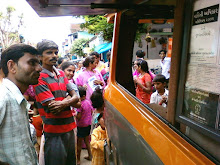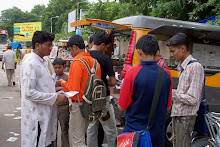India Today: National: Wednesday, July 04, 2018.
In its reply
to India Today's RTI application, the Ganga Rejuvenation Ministry has reported
a 58 per cent increase in contamination from faecal coliform bacteria in the
city's waterway.
As the boat
cruises along the banks, slurries gurgle dark black sewage into the Ganga,
littered with plastic, carcasses and trash. An indescribable stink kicks up
from this toxic cocktail that also hides germs passed through human and animal
excrements.
Along
Varanasi's ghats, lab tests have found bacterial contamination is now higher
than the levels recorded back in 2014 when the Modi government launched its
most ambitious Namami Gange initiative to clean up the river.
In its reply
to India Today's RTI application, the Ganga Rejuvenation Ministry has reported
a 58 per cent increase in contamination from faecal coliform bacteria in the
city's waterway.
More than
2,500 coliform microorganisms in 100 millilitres are considered unsafe for
bathing.
But Ganga
samples collected from Varanasi's Malviya Bridge showed bacterial contamination
almost 20 times higher than the official standards.
Faecal
coliform presence was recorded at 49,000/100ml in 2017 up from 31,000 in 2014
at the bridge location, the government acknowledged in the RTI response.
According to
experts, faecal coliform bacteria indicate sewage contamination and possible
presence of other pathogenic organisms in a waterway.
"There
are five priority drains having flow more than one million litres per day,
which are joining into river Ganga in Varanasi," said the ministry in its
RTI reply, citing data from the Central Pollution Control Board.
Dead aquatic
life is another eyesore along the banks of the ancient city. That may be
because the Ganga is losing its oxygen there.
A tangible
evidence of this trend emerged in the ministry's reply that admitted that
dissolved oxygen at the Assi Ghat has dropped from 8.6 milligram per litre in
2014 to 7.5 milligram in 2017, on the edge of the recommended 5mg/l limit.
This area,
however, reported no change in bacterial contamination that stayed at 2,200 per
100 ml in the 2014-17 period.
India Today's
status check of Namami Gange found that the 2,500-km holy river remains trapped
in pollution at many locations.
It's a nullah
being worshipped. This is the PM's constituency. But there's nothing that
suggests a clean-up
- Local
resident of Varanasi
Remember, the
river passes through a hundred towns and cities and thousands of villages
before it spills into the Bay of Bengal.
According to
the government, it's still absorbing waste everyday from 144 drains in five
Ganga states of Uttarakhand, Uttar Pradesh, Bihar, Jharkhand and West Bengal.
Authorities
have only been able to shut 10 new drains that might have come up in the
interim, the government's response suggests.
In Kanpur,
once called the Manchester of the East, India Today caught on camera
blackish-grey sludge on the city's riverside.
Dirty drains
were also found to be merging unabatedly into the waterways near the Parmat
neighbourhood.
"The
Ganga cannot be cleaned only by the initiatives taken by the government,"
said Amit Dixit, a local resident. "People must also be aware and actively
participate in the cleanliness drive."
The river
pollution in Kanpur has largely been blamed on discharge from the city's
tanneries.
In the past
few years, authorities have closed a number of unauthorised leather factories
at Kanpur's Jajmau area.
Many leather
units have also been shifted out, but many others still continue to operate in
the city.
There were
400 tanneries in Kanpur, which have now been reduced to 50 percent. Around Rs
500 crore is being spent in Kanpur for the Ganga and sewage systems
- Santosh
Kumar Sharma, Municipal commissioner Kanpur
In Bihar,
sewage was found to be cascading into the river in Patna, garbage riddling its
banks.
Contamination
in the Ganga's last lap in West Bengal is higher. It's a state that's home to
222 big and small drains that flow into the river.
"The
Ganga in the northern part of Bengal is the most polluted part of the river,
with a very high count of coliform of over 160,000 per litre," said
Dr. Sugata
Hazra, a professor and director at the Jadavpur university's school of
oceanographic studies.
"Even
the amount of untreated sewage of 1,800 litre per day is disposed to this
river. Now, this water is not suitable for drinking or even bathing as there is
heavy metal contamination," Dr Hazra warned.
Namani Gange
was launched in June 2014 with a total budgetary outlay of Rs 20,000 crore for
a period till December 2020.
Since 2011,
around Rs 8,454 crore has been released by the central government and Rs 4,095
crore by the National Mission for Clean Ganga to rid the river of pollutants,
official records show.
In its
comments, the water resources and Ganga rejuvenation ministry listed a number
of initiatives aimed at the river cleanup in a time-bound manner.
New sewer
treatment projects (STPs) on public private partnership, the first of their
kind in India, are under way at Varanasi, the ministry said.
Two of the
STPs with a capacity to treat 362 MLD of sewage would be complete by October,
it added. Another plant is expected to be ready before March next year.
 |
| A man brushes his teeth as he stands in the polluted water of river Ganga in Kolkata (Photo: Reuters) |
Senior
ministry officials insisted the new STPs would help tackle Ganga pollution
considerably in the prime minister's constituency.
In January
2016, the central government launched what is referred to as a hybrid
annuity-PPP model for sewage treatment with 100 percent central funding.
Under this
model, the development, operation and maintenance of the sewage treatment STPs
is assigned to a special purpose vehicle to be created by the winning bidder at
the local level.
One of the
most important features of this model is that payments are linked to
performance of STPs.
According to
the ministry, authorities were also building Ganga Vatikas at eleven cities
along the river course in order to raise awareness about environment and
cleanliness.
These
Vatikas, said officials, would exhibit films on the Ganga and medicinal herbs
linked to the river.
A Rs 76-crore
STP project at Uttar Pradesh's Anupshahr would also be complete by October,
officials insisted. Work on several other sewage treatment plants was also
underway, they said.
(With inputs
from Nelanshu Shukla, Rohit Kumar Singh, Manogya Loiwal)































